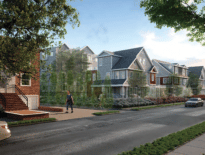
Salim Furth
The Baker administration’s implementation of Massachusetts’ new zoning law, Section 3A, has the potential to reshape and restore town centers throughout Greater Boston and bring rental prices down to a more affordable level. The Department of Housing and Community Development floated draft guidance in December that promises to have a bigger – and better – impact on the Greater Boston housing market than any previous effort, including the contentious 1969 Affordable Housing Law, known as “40B.” As a uniquely New England approach, it can strengthen the local civic life for which our towns have historically been known.
Section 3A would incentivize 175 Greater Boston cities and towns to zone for multifamily housing near transit stations or, in the absence of transit, other appropriate locations. To qualify for grants, towns must allow 15 homes per acre, giving builders flexibility to provide low- or moderate-density housing. A town could qualify, for example, by allowing six-unit buildings on one-third-acre lots. Each town has a specific zoning target based on its size and level of transit service; existing multifamily zones can count toward the target.
As drafted, the Baker administration’s implementation guidelines would make Section 3A a national model of state housing legislation. The rules preserve local governance: Towns retain the authority to design and map new qualifying zones and can opt out entirely at the cost of eligibility for state capital grants. Unlike some state interventions, Section 3A is not freighted down with “value capture” provisions which perversely require builders, who are providing much-needed housing, to also fund rent subsidies and other benefits which, if enacted, ought to be every taxpayer’s responsibility.
Unlike California, which relies on uncertain, politicized lawsuits to enforce its “fair share” housing law, Section 3A is self-enforcing: If a town opts out of allowing housing growth, the state opts out of funding infrastructure expansions in that town. It makes sense. After all, if a town is not growing, it has less need of new infrastructure. Towns that quickly cooperate may face some growing pains, but they will also be first in line for MassWorks and Local Capital Projects funding to ease the transition.
How to Help Ensure Success
Having released the draft guidelines, the Baker administration is seeking public comments on Section 3A through March 31.
Workers and businesspeople in the Massachusetts real estate industry should engage vocally in this public discussion. They stand to benefit from a new approach to homebuilding that emphasizes simple approval processes, opportunities across many communities the creation of housing that will allow tradespeople to buy homes in the towns where they work.
The first step is to submit a comment on the draft guidelines, encouraging DHCD to continue the existing, ambitious approach and identifying any ambiguities in the guidelines. Second, those who work closely with town governments can help explain what Section 3A means for them. If they rezoned, what types of homes would make sense? What prices would new housing fetch? Demystifying the process can help town officials who have the unenviable task of proposing significant zoning changes to town meeting members.
Finally, people committed to making Section 3A work should step up and participate in public meetings and the public discussion of zoning in their own towns. Local government relies on citizens bringing expertise and advocacy from their day jobs. Developers, tradespeople and others can inform their town’s feedback to DHCD and subsequently work with neighbors to ensure that their town’s rezoning is well-designed to strengthen the community as well as meet DHCD’s guidelines.
Rejuvenation for Town Centers
Section 3A can be consequential, maybe even transformational. But what kind of state will it leave Massachusetts? Although change is always uncertain, I think that it can be implemented in ways that help restore town centers to their role as cores of community life.
Strict zoning governing post-World War II suburbanization often deflected growth away from the town greens that had been community hubs for generations. Instead of intensifying town life, suburbanization drew businesses out to highways and new residents into subdivisions and self-contained apartment complexes. Town centers sometimes thrived, but often became quaint and irrelevant.
Many Massachusetts communities have become hostile to growth of any kind. No New Englander drives through the contemporary suburbs of Atlanta or Phoenix and wishes for more endless, undifferentiated suburbia. Yet those cities offer attainable home prices and true housing choice, which Greater Boston does not. Can towns expand opportunity without losing their identities?
Section 3A offers a new, old-fashioned way. Qualifying towns will zone land for at least 750 homes, typically in a town center location alongside a commuter rail station. But towns can allow other uses, such as starter homes on small lots and ground-floor retail, giving the new districts flexibility to meet a variety of needs.
In the region’s longstanding suburban areas, rezoning will strengthen older village centers. Rather than putting cars onto highways, as most postwar growth has done, town-center growth can put shoes onto sidewalks, reinvigorating local businesses. Farther from Boston, in towns where most land is still forested or farmed, Section 3A will channel growth toward the traditional New England approach, showing that Massachusetts can offer homes to more families without losing its identity.
Salim Furth is a senior research fellow with the Mercatus Center at George Mason University.





